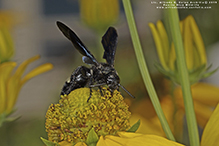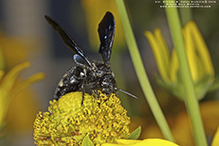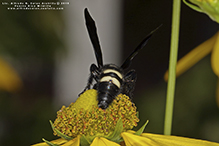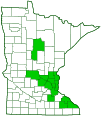Double-banded scoliid wasp
(Scolia bicincta)
Conservation • Description • Habitat • Ecology • Distribution • Taxonomy
Conservation Status |
|
||||
| IUCN Red List | not listed |
||||
| NatureServe | not listed |
||||
| Minnesota | not listed |
||||
Description |
Double-banded scoliid wasp is a large, conspicuous, easily recognized, stinging wasp. It occurs in the United States east of the Great Plains and in southern Ontario Canada. It is uncommon in the southeastern quarter of Minnesota, mostly absent in the remainder of the state. The larva is an external parasite on beetle grubs. Adults are found in fields on flowers from July to September. Adults are robust, dark, hairy, and ⅝″ to 1″ (15 to 25 mm) in length. The head is entirely black. The antennae on the female have 12 segments. Those on the male have 13 segments and are noticeably longer. The thorax is entirely black. On the underside of the thorax, the exoskeletal plate on the second segment (mesosternum) and third segment (metasternum) form a large plate divided by a transverse, line-like groove (suture). The abdomen on the female has 6 segments. It is black except for a broad white band across the upper side of the second and third segments. The front and rear margins of the bands are often grooved in the middle. Sometimes the rear band or both bands are broken into a pair of spots. There is a stinger at the tip that is retracted when not in use. The abdomen on the male has 7 segments and a retractable, 3-pronged, pseudo-stinger at the tip, but is otherwise similar. The legs are hairy and entirely black. The bases of the hind legs are well separated. The wings are black with bluish reflections. The wing veins do not reach the outer margin. The area beyond the closed cells has numerous longitudinal wrinkles. The forewing has 2 submarginal cells. Occasionally a wasp will have one or more additional white spots, including but not limited to a small spot behind each compound eye, a spot at the base of each antenna, a spot on the plate covering the base of each forewing (tegula), a pair of spots or a narrow band across the first abdominal segment, and a pair of spots on the fourth abdominal segment. |
Size |
⅝″ to 1″ (15 to 25 mm) |
Similar Species |
Habitat |
Fields |
Ecology |
Season |
July to September |
Behavior |
|
Life Cycle |
The female can somehow detect a beetle larva (grub) underground. When she locates one, she digs down to it, stings to paralyze it, lays a single egg on it, and flies away. Sometimes she will move it deeper into the ground and create a small chamber before laying the egg. When the egg hatches, the larva feeds on the grub from the outside. Mature larvae spin a cocoon and overwinter in the cocoon. Adults emerge from the ground the following summer. |
Larva Hosts |
Beetle grubs |
Adult Food |
Flower nectar |
Distribution |
||
|
Sources |
|
| 8/23/2025 | ||
Occurrence |
||
|
||
Taxonomy |
|
Order |
Hymenoptera (Ants, Bees, Wasps, and Sawflies) |
Suborder |
Apocrita (Narrow-waisted Wasps, Ants, and Bees) |
Infraorder |
Aculeata (Ants, Bees, and Stinging Wasps) |
Superfamily |
Scolioidea (scolid wasp) |
Family |
Scoliidae (scolid wasps) |
Subfamily |
Scoliinae |
Tribe |
Scoliini |
Genus |
Scolia |
Subordinate Taxa |
|
|
|
Synonyms |
|
|
|
Common Names |
|
double-banded scoliid wasp |
|
Glossary
Tegula
A small, hardened, plate, scale, or flap-like structure that overlaps the base of the forewing of insects in the orders Lepidoptera, Hymenoptera, Diptera, and Homoptera. Plural: tegulae.
Visitor Photos |
Share your photo of this insect. |
||
This button not working for you? |
||
Luciearl |
||
 |
 |
|
Bee/Wasp on goldenrod |
||
Megan V. |
 |
We have seen several in our pool this year! They are quite large and the blue is distinguishable on them. |
JJ |
 |
Alfredo Colon |
||
 |
 |
|
 |
||
Maureen Burkle |
 |
MinnesotaSeasons.com Photos |
|

Slideshows |
|

Visitor Videos |
Share your video of this insect. |
||
This button not working for you? |
||
|
Other Videos |
DOUBLE BANDED SCOLIID WASP Scolia bicincta |
About
Oct 24, 2017 Scolia bicincta DOUBLE-BANDED SCOLIID WASP visiting flowers. Stonefort, IL 9/2/2017. |

Visitor Sightings |
Report a sighting of this insect. |
||
This button not working for you? |
||
Luciearl |
Location: Lake Shore, MN |
 |
Megan V. |
Location: Apple Valley, MN We have seen several in our pool this year! They are quite large and the blue is distinguishable on them. |
| JJ 7/26/2023 |
Location: Minnehaha, Minneapolis |
 |
| Maureen Burkle 8/8/2022 |
Location: Rochester, MN |
 |
| Alfredo Colon 8/14/2019 |
Location: Woodbury, Minnesota |
 |
MinnesotaSeasons.com Sightings |
|

|
Created: 8/18/2022 Last Updated: © MinnesotaSeasons.com. All rights reserved. |

